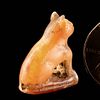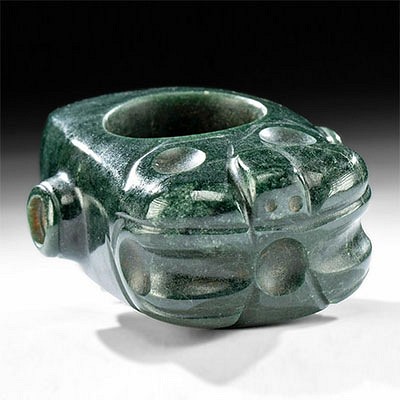Egyptian Carnelian Bead - Cat / Bastet Amulet
Lot 13
About Seller
Artemis Fine Arts
686 S Taylor Ave, Ste 106
Louisville, CO 80027
United States
Selling antiquities, ancient and ethnographic art online since 1993, Artemis Gallery specializes in Classical Antiquities (Egyptian, Greek, Roman, Near Eastern), Asian, Pre-Columbian, African / Tribal / Oceanographic art. Our extensive inventory includes pottery, stone, metal, wood, glass and textil...Read more
Categories
Estimate:
$1,200 - $1,800
Absentee vs Live bid
Two ways to bid:
- Leave a max absentee bid and the platform will bid on your behalf up to your maximum bid during the live auction.
- Bid live during the auction and your bids will be submitted real-time to the auctioneer.
Bid Increments
| Price | Bid Increment |
|---|---|
| $0 | $25 |
| $300 | $50 |
| $1,000 | $100 |
| $2,000 | $250 |
| $5,000 | $500 |
| $10,000 | $1,000 |
| $20,000 | $2,500 |
| $50,000 | $5,000 |
| $100,000 | $10,000 |
| $200,000 | $20,000 |
About Auction
By Artemis Fine Arts
Sep 10, 2020
Set Reminder
2020-09-10 10:00:00
2020-09-10 10:00:00
America/New_York
Bidsquare
Bidsquare : Antiquities | Asian | Ethnographic Art
https://www.bidsquare.com/auctions/artemis-gallery/antiquities-asian-ethnographic-art-5546
Featuring classical antiquities, ancient and ethnographic art from cultures encompassing the globe. Egyptian, Greek, Roman, Etruscan, Near Eastern, Asian, Pre-Columbian, Native American, African / Tribal, Oceanic, Spanish Colonial, Russian, Fossils, Fine Art, more! Artemis Fine Arts info@artemisgallery.com
Featuring classical antiquities, ancient and ethnographic art from cultures encompassing the globe. Egyptian, Greek, Roman, Etruscan, Near Eastern, Asian, Pre-Columbian, Native American, African / Tribal, Oceanic, Spanish Colonial, Russian, Fossils, Fine Art, more! Artemis Fine Arts info@artemisgallery.com
- Lot Description
Ancient Egypt, Late Dynastic period, ca. 712 to 332 BCE. This dainty hand-carved and hand-drilled carnelian bead is a beautiful vermillion hue with swirls of white inclusions. Seated on its haunches, tail curved around its body, effortlessly regal, this cat, perhaps representing Bastet, is carved with meticulous detail to its face, a task of a delicate and skilled artisan! The front limbs have a shallow groove to indicate two legs with incised lines on the paws to denote toes and to delineate the flat base it sits upon from the body. A perforation through the base allows this bead to be strung as an amulet, a popular practice to protect the wearer, and this elegant cat represents good health. Size: .5" W x .75" H (1.3 cm x 1.9 cm)
Cats played an important role in ancient Egyptian culture and today's housecats come from the domestication of wild cats that lived along the Nile. The aloofness and aura of mystery that cats held, captivated the imagination and quickly transfromed them into deity figures, represented by Bastet, the cat headed goddess of good health and daughter of the sun god Ra. The Egyptian word for amulet meant "protector" and the specific amulet form would help the wearer overcome certain obstacles. The type of stone used was also important, and carnelian was particulary protective.
Provenance: ex-Phoenicia Holyland Antiquities
All items legal to buy/sell under U.S. Statute covering cultural patrimony Code 2600, CHAPTER 14, and are guaranteed to be as described or your money back.
A Certificate of Authenticity will accompany all winning bids.
We ship worldwide and handle all shipping in-house for your convenience.
#157849Hairline fissure on base. Fine details and mineral deposits.Condition
- Shipping Info
-
All shipping is handled in-house for your convenience. Your invoice from Artemis Gallery will include shipping calculation instructions. If in doubt, please inquire BEFORE bidding for estimated shipping costs for individual items.
-
- Buyer's Premium



 EUR
EUR CAD
CAD AUD
AUD GBP
GBP MXN
MXN HKD
HKD CNY
CNY MYR
MYR SEK
SEK SGD
SGD CHF
CHF THB
THB















